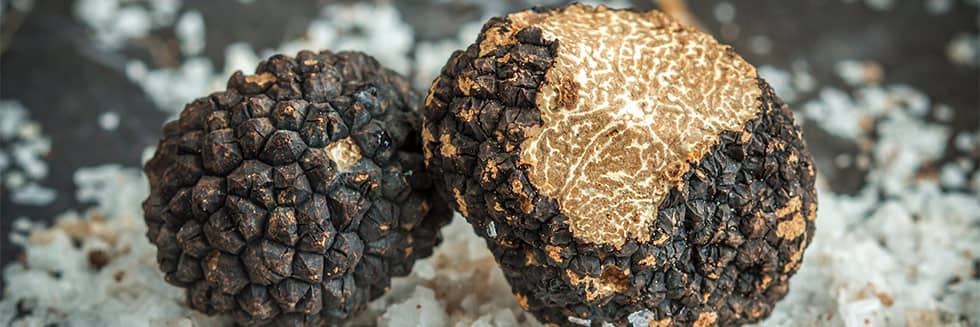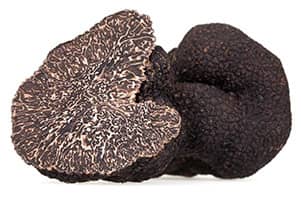
How to produce the Burgundy truffle ?
Characteristics of the Burgundy truffle
 The Burgundy truffle, also called autumn truffle (because of its hunting period), belongs to the Tuberaceae family. This edible mushroom is said to be "hypogeous" because it grows underground. It is also a "mycorrhizal" mushroom, which means that the truffle lives in symbiosis with a host tree, most often a pubescent oak, a pedunculate oak or a hazelnut tree.
The Burgundy truffle, also called autumn truffle (because of its hunting period), belongs to the Tuberaceae family. This edible mushroom is said to be "hypogeous" because it grows underground. It is also a "mycorrhizal" mushroom, which means that the truffle lives in symbiosis with a host tree, most often a pubescent oak, a pedunculate oak or a hazelnut tree.
Tuber uncinatum is characterized by its external appearance (its peridium) decidedly black and warty. Its flesh is light brown, marked by numerous fine white veins more or less dense. Very appreciated by the gastronomes, the truffle of Burgundy offers a rather light taste which reminds that of the hazelnut with a characteristic smokiness in more. Some also attribute to it a note of undergrowth. Burgundy truffles mature during the fall and are harvested from mid-September to the end of December.
Soils and climates suitable for the Burgundy truffle farming
The Burgundy truffle has difficulty withstanding the high summer heat. This is why, compared to the black truffle, it grows in less hot regions or at higher altitudes. As its vernacular name indicates, the Burgundy truffle is mainly found in the central-eastern part of France (in Burgundy, Champagne, Lorraine and Alsace). But Tuber uncinatum is also cultivated in many European countries: Switzerland, Germany, Spain, Italy, Bulgaria and Hungary.
Although it is not very demanding in terms of soil, the Burgundy truffle nevertheless shows a preference for alkaline, well-drained soils with an exchangeable calcium content of around 10 to 15%. Ideally, the soil should be fertile, silty and organic, with a carbon/nitrogen ratio of up to 20. Note that a high clay content can be a problem (maximum 40%).
Soils favoring the development of Tuber uncinatum
The Burgundy truffle requires a clay-limestone soil (up to 40% clay and 10 to 15% limestone), slightly basic (optimal pH between 7 and 8). The organic matter content can be high (up to 20%) as well as the C/N ratio which can also reach 20%. The favorable soils are generally shallow, 10 to 30 cm, granular, made up of compact but permeable and slightly fissured rocks.
We remind you that each truffle species has specific requirements, we advise you to carry out a soil analysis to check if your land is suitable for truffle growing and to define the most suitable truffle species. We can arrange for this analysis to be carried out by our partner, the Teyssier laboratory, which specializes in soil analysis for truffle growing.
Climat de prédilection de la truffe de Bourgogne
La truffe de Bourgogne s'accommode parfaitement de terrains en pente douce ou de plateaux situés à une altitude de 100 à 1300m, avec une exposition Nord, Nord-Est ou Est (et oui, Tuber uncinatum préfère l'ombre contrairement à Tuber melanosporum...). Les truffières Tuber uncinatum supportent les climats variés pouvant aller de climat océanique à continental. En effet, à la différence de la truffe noire, celle de Bourgogne s'acclimate du gel, sans pour autant supporter de longues périodes de très grand froid : Quand les premières gelées automnales surviennent, sa croissance est déjà terminée si bien qu'elle est en mesure de résister à des températures négatives "modérées".
Irrigation et besoin en eau de la truffe de Bourgogne
Trois facteurs clés conditionnent la croissance et le maintien des truffes de Bourgogne:
• Une pluviométrie relativement importante et bien répartie pendant les mois d'été, puisque la productivité de la truffière est en général corrélée positivement à la quantité d’eau reçue pendant l’été.
• Un apport minimum de 50-60 mm par mois en mai, juin, juillet, août et septembre pour assurer la bonne formation des truffes.
• L'absence de ruptures hydriques (périodes de sécheresse) de plus de 20 jours.
Mycorrhization of young plants by the Burgundy truffle
Naturally, many forest species can live in symbiosis with the Burgundy truffle. The best known are the oaks and hazelnut trees, but Tuber Uncinatum also develops harmoniously with a hornbeam, a cedar, a pine or a beech. Moreover, each of these species responds favorably to controlled mycorrhization so that you now have If the two most used host species for the cultivation of Burgundy truffles remain the truffle oaks and the truffle hazelnuts, Robin Nurseries offers a much wider range of host species. This wide choice of ROBIN TRUFFLE PLANTS allows us to adapt to the different constraints and conditions encountered in the field (climate, exposure, altitude, hygrometry...).
Below, you will find all the host species proposed by ROBIN Nurseries after mycorrhization with the Burgundy truffle :
- Turkey oak mycorrhized with burgundy truffle
- Pedunculate oak mycorrhized with burgundy truffle
- Pubescent oak mycorrhized with the burgundy truffle
- Common hazelnut mycorrhized with burgundy truffle
- Turkish hazel mycorrhized with burgundy truffle
- Fertile Coutard fruit hazel mycorrhized with burgundy truffle
- Tonda Gentile fruit hazel mycorrhized with burgundy truffle
Thanks to their high level of performance, these plants allow you to produce your own Burgundy truffles. Please note that depending on the age of the plant and the land chosen to plant it, you will have to wait between 6 and 7 years to harvest your first Burgundy truffles.
ROBIN TRUFFLE PLANTS mycorhized with the Burgundy truffle are available in ROBIN ANTI-CHIGNON® buckets in 4 different sizes: from 0.43 to 3 liters. These are high quality plants produced in our nursery by techniques developed within the framework of our quality system and under license from INRAE (National Research Institute for Agriculture, Food and the Environment).
You hesitate between several plants? You are not sure to choose the most suitable host species for your truffle plantation project? For the realization of your Burgundy truffle orchard, do not hesitate to contact the sales manager of your sector, he will be able to advise you and accompany you step by step.
10 questions and answers about the culture of the Burgundy truffle
The Burgundy truffle can be found under an oak tree, a hazelnut tree or a pine tree. Beech, cedar, hornbeam and lime trees can also hide this rare mushroom.
The East of France is the basin of predilection of the Tuber uncinatum. It is mainly found in Burgundy, Lorraine and Champagne-Ardenne. It should be noted that the Burgundy truffle is also cultivated outside our borders, in Spain but also in Italy, Switzerland, Germany and in the Eastern countries.
The biological cycle of the tuber uncinatum is as follows: birth of the truffles at the beginning of the year (January/February), development thanks to the various spring rains, growth until the end of the summer, ripening throughout the autumn, arrival at full maturity at the end of autumn. Harvest from mid-September to the end of December.
If oaks and hazelnut trees are excellent candidates for the cultivation of Burgundy truffles, it is also possible to produce them from plants of hornbeam, cedar, linden, pine or even beech; provided that these plants are previously mycorhized with tuber uninatum.
Depending on the host species of the chosen plant (oak, hazelnut, cedar, pine...) and its age, the price of a truffle plant mycorhized with the Burgundy truffle varies between about 16 € and 31 € per unit. Note that these prices are decreasing according to the number of plants ordered.
A truffle tree starts to produce around 6 or 7 years old depending on the host species and the quality of the care given to the plantation (soil work, pruning, watering...). The production can then vary from 20 to 80 kilos per hectare, around the 13th year in the case of tuber uncinatum.
Truffle growing requires patience. For Tuber uncinatum, the first harvest of ROBIN truffle plants is from the 6th or 7th year.
The Burgundy truffle is particularly afraid of :
• lack of water during the summer months (from June to September). It does not tolerate drought for more than 20 days.
• excessive and prolonged sunshine (Tuber uncinatum prefers shade).
The Burgundy truffle is generally traded at around 300 to 600 € per kilo (a little less at the beginning of the season, a little more for the most beautiful specimens when fully mature). This price, although expensive, remains lower than the black truffle price which can rise to 800 or 1000 € per kilo !
Truffle plants can be found and purchased in specialized nurseries such as ROBIN Nurseries. If you live near our sales points (department of 04 and 05), do not hesitate to visit us, you will benefit from precious advices before starting. Otherwise, you can buy your Tuber uncinatum truffle plants directly online, via this website. They will be delivered to your home !